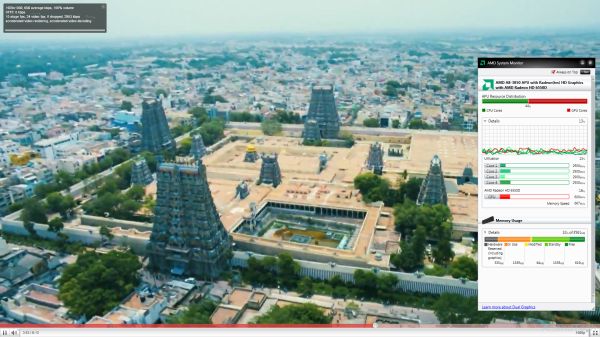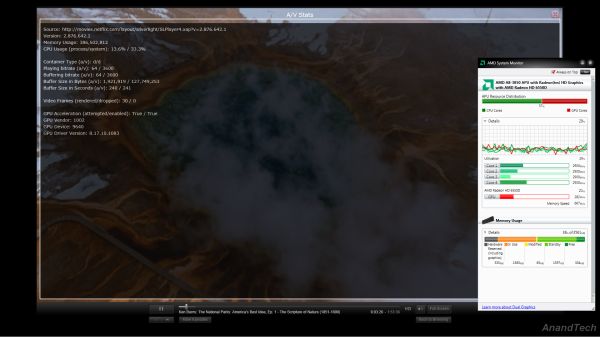AMD A8-3850 : An HTPC Perspective
by Ganesh T S on June 30, 2011 6:20 AM EST
3D Blu-ray Playback CPU Load
We saw in one of the previous sections that the 6550D doesn't have the same MVC decode feature of the 6xxx GPUs. We took the 3D Blu-ray version of Alice in Wonderland for a spin and played it on the 6550D as well as the 6570 (not in CrossFire mode). As expected, the 6570 had marginally lesser CPU utilization. The GPU load (not recorded here) was also lesser compared to the 6550D (that is to be expected because of the difference in the DRAM and GPU core clocks). We also recorded the CPU load while playing a 2D Blu-ray (HQV Benchmark) on the 6550D. It gives an indication of the CPU assistance required by the 3D Blu-rays.
| Blu-ray Playback CPU Usage | ||
| Alice in Wonderland [3D] (6550D) | 21% | |
| Alice in Wonderland [3D] (Sapphire 6570) | 16% | |
| HQV 2.0 Benchmark Blu-ray [2D] (6550D) | 12% | |
Steady Video
AMD is also advertising 'Steady Video', a feature to make your shaky hand held videos such as those from the PlaySports and the Flips look more stabilized. This requires the CPU and the GPU to work in close conjunction. The good aspect is that 'Steady Video' is available even when playing back videos in MPC-HC. For reasonably steady videos, it works wonders, but fails in places where it really matters (like videos taken while walking, where there is a lot of scene change as well as shakiness). The bad aspects come in when one tries to be aggressive with the steady video algorithms. Sometimes, the image quality suffered, while there were lip sync errors in other cases. Even in videos where it is effective, there are slight periodic jerks.
All in all, our opinion is that this is a good feature for the marketing department to advertise. Note that Cyberlink has been having a True Theater Image Stabiliser for camcorder videos since PowerDVD 10. That feature works across all CPU / GPU combinations.
YouTube and Netflix
The good news is that hardware acceleration is present and works for both YouTube and Netflix, as the screenshots below show.
Power Numbers
We put our testbed through some typical activity and recorded the average power consumption numbers. Note that these numbers are relevant only when compared with the idle playback power consumption. Different testbeds may end up with different power consumption numbers.
| Llano HTPC Testbed Average Power Consumption (W) | ||
| Idle | 36.1 | |
| 1080p MKV from SSD | 49.1 | |
| 2D Physical Blu-ray Playback | 57.1 | |
| Call of Pripyat Benchmark (Max. settings) | 91.8 | |
| Prime 95 + Furmark | 141.2 | |
Miscellaneous Notes
We are yet to evaluate some important aspects like RGB - YUV colour conversion accuracy and audio channel mapping in 7.1 channel configurations. AMD is looking into the local file playback having high GPU load issue also. By the time we evaluate the next HTPC / HTPC GPU, some Catalyst releases should have passed by. Expect further analysis of the AMD 6550D in those pieces, particularly with respect to the aspects we have missed covering in this review.












104 Comments
View All Comments
Regenweald - Sunday, July 3, 2011 - link
Have to disagree with you here, technology isn't about 'points for effort' but raw performance. the Stars IPC is abysmal in comparison to SB, call it as such. In the same way In HTPC as well as 3D performance, Intel IGPs are still scraping the bottom of the barrel in comparison to the A-Series, call it as such. Which consumer buys second best because 'they're really trying' ?Lower power consumption, better performance A-Series comes out on top this time. It's ok to say it :)
garagisti - Friday, July 1, 2011 - link
Also, if you didn't find any links saying Intel supports 7.1 channel 24-bit hd audio bit-streaming over hdmi, you could have mentioned it in the review. I don't see Intel claiming it. AMD DOES feature that in their graphic parts with HD68xx series and above. I don't know if Llano features it or not, but i'd like to find out given this is a HTPC benchmark.Targon - Friday, July 1, 2011 - link
And just think about prices when HP starts releasing low-end systems with Llano. Most of us look at system prices that START at $500 and go up from there, while most end users look at the $500 mark as being near the top of what they want to spend and then go down from there.If this becomes the $400 machine, doesn't that make for a MUCH better purchase than a $500 i3 system that has similar performance numbers?
ganeshts - Friday, July 1, 2011 - link
Just a small observation that many users will be happy to invest the extra ~$100 to make sure that they can play back their $1000 1080p60 camcorder's clips.I wrote this in another comment, but I will repeat: The choice depends on what the end user wants to do with the system.
Regenweald - Sunday, July 3, 2011 - link
I'd argue that the person buying the $1000 camcorder is not looking for a sub $500 PC. For the person buying the Flip or Sanyo Xacti sub $300, Llano is their territory.ganeshts - Friday, July 1, 2011 - link
HQV testing : When the picture quality doesn't materialise for local files / local file playback has more issues with respect to higher GPU load, do you want us to recommend the system ?I respect the intelligence of the readers to the extent that they identify what is right and wrong with the hardware from what is presented.
Again, we reiterate : If you do even a bit of gaming on your PC, the Llano is a much much better bet than Intel. When it comes to HTPCs, though, take a hard look at what it does and what it doesn't. If you don't care about 1080p60 camcorder clips, then the Llano is a better choice for its 'proper' support of 23.976 Hz, and better deinterlacing capability. On the other hand, if all you play is downloaded MKVs which are progressive in nature, you will be happy with the higher CPU power provided by Intel since its iGPU is good enough in THAT scenario. All these facts are presented in the review, and it is up to the reader to see whether the pros outweigh the cons in HIS particular scenario.
As for HD audio bitstreaming, LAV Splitter + LAV Audio Decoder bitstreamed all the HD audio codecs to the AVR correctly. Proper bitstreaming support is a given in systems nowadays. In today's systems, It only deserves mention if something doesn't work. Also, I looked into AVSForum threads talking about 24-bit TrueHD streams, and many of the posters had SNB systems. Not one of them complained about any issues with HD audio bitstreaming of that content.
swaaye - Thursday, June 30, 2011 - link
Thanks for the thorough review. It gives a good overview of Lllano's virtues for video playback. Hopefully they clean up the software quickly. It's particularly annoying to see the Enforce Smooth Playback option causing problems when it has been in their drivers for year(s) now.Targon - Friday, July 1, 2011 - link
That 32nm process node has been a long time coming from AMD, hasn't it?redisnidma - Friday, July 1, 2011 - link
I'm sorry if I'm about to hurt some feelings here, but I also agree with the rest of the guys in regards to the bias in Anandtech reviews. This one about Llano is no exception.Ganesh is quick to point out that Llano doesn't offer transcoding features like Intel's Quicksync, even though he doesn't mentions that the quality output of quicksync is CRAP; but when it comes to promote a handy feature like SteadyVideo (which llano supports), he's quick to shout out to the public about the negative aspects of it.
These guys, (Anand and the bunch) are quick to criticize Llano's CPU and make a whole fuzz about it, but on the other hand they dare to call Sandybridge's iGPU as "average" and "OK" which in reality is total crap.
This site is unbelievable, but anyhow, it's good to know that people are noticing it.
ganeshts - Friday, July 1, 2011 - link
I am not a big fan of QuickSync myself (take a look at my observations in the article).IIRC, Anand's review indicated that QuickSync's output quality was much better than the GPU based encoding techniques promoted by NVIDIA. And the ATI Stream technology seemed to generate something close to the QuickSync quality, albeit with a much lower performance.
Basically, I consider QuickSync useless unless we can get the sort of quality that proper options to x264 can provide.